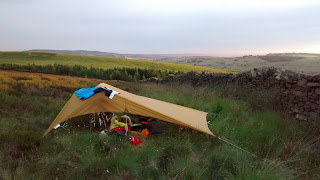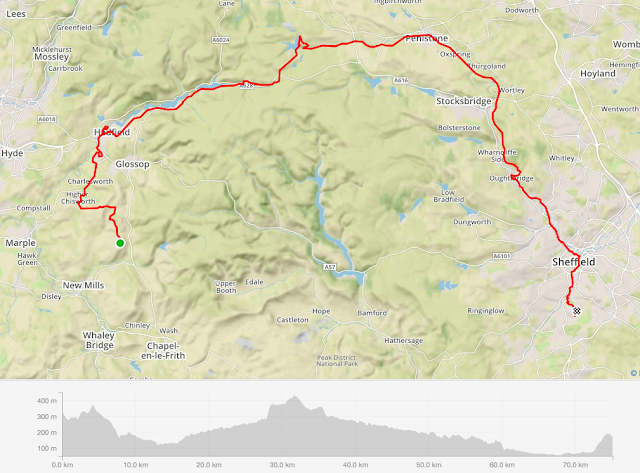 |
| Vittoria Trail Tech tyres |
I just bought a pair of "Vittoria Trail Tech Tubeless Ready Folding Tyres" on sale from Planet X; they're currently on sale for
14 quid each down from a claimed RRP of 40 quid - although I'm pretty certain Planet X never sold them for that price. Nevertheless, 14 quid for a tubeless-ready folding tyre really is a decent bargain. One thing though was, despite deploying my awesome Googling skills, I couldn't find out much about the tyres in advance of buying them. So now I've fitted them and used them, I thought I'd do a quick review just in case anyone else is thinking about buying a pair.
 |
| According to Strava I was much quicker up here than on my mountain bike! |
The Vittoria tyres are replacing some Panracer Gravel King SKs, which are light, fast and feel super comfy to ride on, but back in December, on a cold early morning on my commute, I punctured one on sharp stone; covering my bike with sealant (which didn't work to seal the puncture). After much hassle removing the tubeless-valve I eventually got a spare tube and made it to work (late) and home again in the evening. After cleaning everything up I used a plug on the hole and re-mounted the tyres, but the plug never sealed and the tyre would go down in a couple of kms. After various hours getting very cold hands, out in the garage, over a number of nights and still failing to get a plug to work, I gave up and put an old super-heavy but almost puncture-proof Schwalbe Marathon Plus Tour, a tubed-tyre, on that wheel and got on with a cold winter of commuting. I bought special tubeless patches you glue on the inside of tyre of the damaged Gravel King, hoping that would fix it, so once I got the new wheels a few weeks ago, re-mounted it. But the patch wasn't working, it leaked at the original puncture, and as the pressure went down (sealant leaking out of the tread), it would also burp at the rim and sealant would start leaking there as well. So I'm not very impressed with the Gravel King SKs longevity. Buying a new one as a replacement was going to be slightly more than a pair of Vittoria Trail Techs at the sale price.

When I got the Trail Techs my first impression was weight! They felt more like the famously heavy Marathon Plus range. It felt a bit of a shame putting them on my lovely new light (for me at least) wheels - Hunt 4S Discs. I weighed one - 740 grams, so about double a Gravel King, but 150 grams less than the Marathon Tour Plus, and I don't need a tube in the Trail Techs so that saves another couple of hundred grams. So, yes, much heavier than the Panracers but quite a lot less than a tubed Marathon. The Trail Techs have a "
Solid Shielding puncture protection layer" that, in the picture below that Google did turn up, looks quite similar to way Schwalbe makes Marathon Plus tyres so puncture resistant. Then of course, set up tubeless with sealant in them, I'm hoping punctures should be a non-issue. I do most of miles commuting to work so not puncturing, and making me late, is more important than saving a few hundred grams although it might make me a second or so slower on my regular Strava segments!
 |
| Borrowed picture showing puncture protection |
When I first tried putting a Trail Tech on my rims it was a total battle. Having mounted different Schwalbe Marathon models over the years - famed for being hard to fit - this was upsetting as it calls into question my a) self-appointed expert tire changer status and b) manhood. After composing myself, wiping away the tears, and watching a few YouTube "how to fit tight tires" vids for inspiration, I had another go and buy really forcing the beads of the tyres in the well of the rim and working down, managed to get it on. Oddly the second tyre went on the second rim more easily, although I still wouldn't say it was easy! I had my home made compressor out ready to blast them on to the rim, but before doing that, thought I'd give it a few blasts with just the track pump so see if, on the off chance, that would work. I was quite amazed when, yep, it was that easy and after a few pumps the bead of the tyre clipped onto the rim with a couple of satisfying pops. Compared to the utter hassle of getting the Gravel Kings set up tubeless, this was a breeze.
 |
| So that was surprisingly easy! |
I added sealant through the valves - all very nice and un-messy - and re-pumped them. They tyres say that tubeless the pressure should be a minimum of 45 PSI which seems quite high, and a max of 90 PSI - which seems amazingly high for a tubeless tyre - I think gravel kings say max of 60. I tried 50 PSI to start of with, but may drop it a bit as they felt relatively firm, although that might have just been due to being a heavier duty tyre than the Panracers.
 |
| Bridleway bashing... |
I took the bike out on 25 km local loop and did both an ascent and descent that I normally ride on my mountain bike. On the ascent (Johnnygate Lane for any Sheffield/Chesterfield locals) I set a new PR according to Strava which I'm pretty happy with. It's really dry out currently, so on dry gravel and hard compacted mud (covered of course in Derbyshire's finest rocks, twigs, leaves etc.) the Trail Techs felt as good as the Gravel King SKs and better than the Schwalbe G-One Speeds my bike came with. Once onto tarmac they are noticeably quieter than the SKs and didn't feel squirrelly on fast descents on road.
 |
| ...or tarmac cruising. |
So after setting them up and a first ride - I'm pretty happy. Yes, they don't have tan sidewalls - so I'm not cool anymore but they seem to grip, in dry conditions at least, as well as the Panracers. Instead of tan sidewalls they do have a reflective sidewall and, again, as a commuter come the autumn I'll be happy about that. Reflective sidewalls are a great feature if you ride at night in traffic. If the Trail Techs turn out to be as puncture resistant as they look, particularly for commuting, that's a big plus. Yes, they're heavier than the Gravel Kings, but after getting hole that I couldn't fix in one, I had to replace it with heavy reliable tubed tire anyway - so the weight point has been moot for months anyway. And at £14.00 each versus £30.00, and being able to set up tubeless so easily, I reckon they're pretty good value.



















































